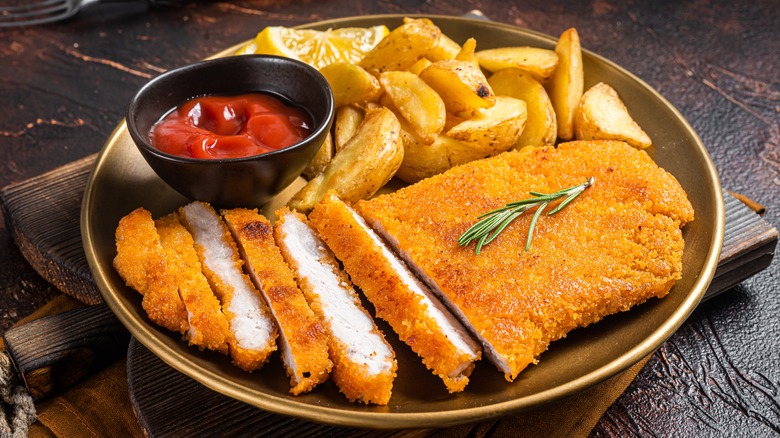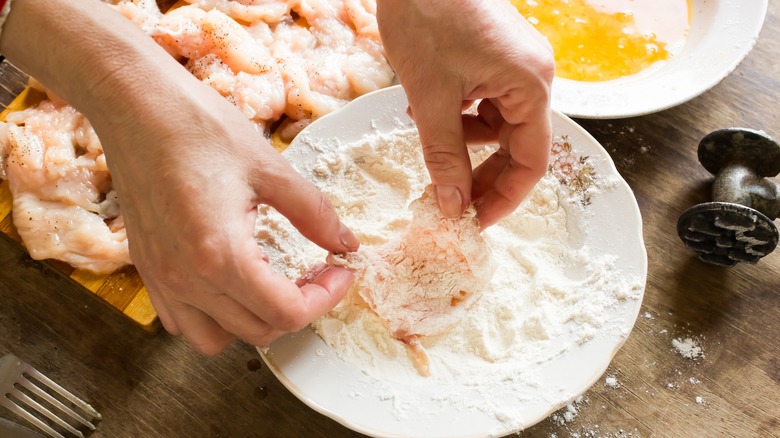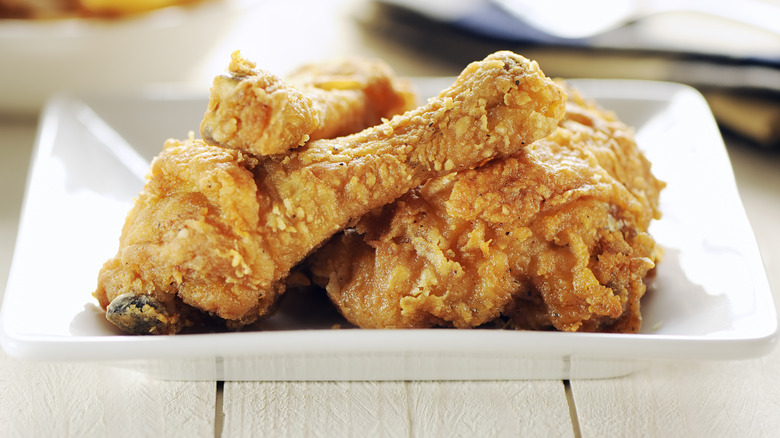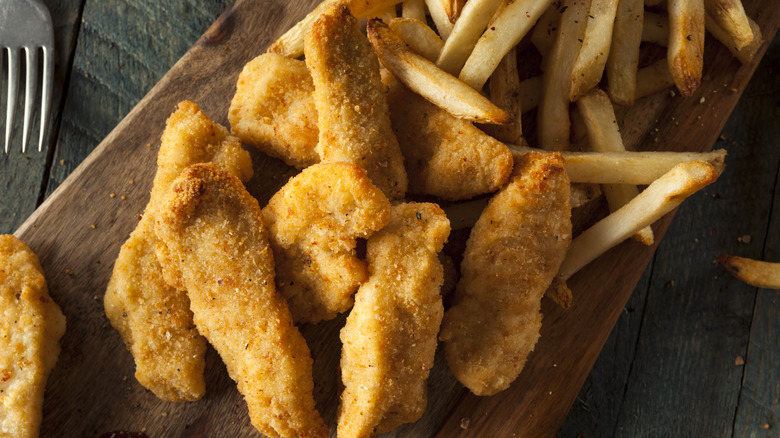Why Your Chicken Breading Won't Stick And How To Fix It
Crispy breaded chicken — whether deep-fried, oven-baked, or air-fried — is kind of divine. You can dip it in delectable sauces, punch up the flavor with a seasoning toss, or keep it simple. The meat stays tender and juicy while the crust gives a craveable crunch. At least, the crust should give a craveable crunch — that is unless the crust slides right off, resulting in breaded chicken heartbreak.
There are reasons why the breading won't adhere when you are deep-frying — like the oil being too hot or too cold or messing with the chicken pieces too much while they are frying, but then why does the breading also fall off when baking or air-frying? Well, it starts at the very beginning while you are preparing the chicken, and there are steps you can take at each stage of the breading process to ensure optimal crust adhesion.
If the chicken is not dried off sufficiently, it creates a slick layer that any flour or starch doesn't stand a chance of sticking to. Too much of a dredge can cause problems, too. Select the right breading, fry at the correct temperature, and treat your chicken appropriately once it comes out of the oil, and you shouldn't have any breaded chicken sorrow.
How to prepare and dredge your chicken
Dry chicken is the most important thing here. No, not dry, cooked chicken — no one wants that. You need your raw chicken to be dry from the start. Simply pat your chicken cutlets or bone-in pieces dry with a paper towel. The same is true for chicken that has soaked in a wet marinade like soy sauce. The exception to this rule is chicken marinated in buttermilk or another thicker dairy product like sour cream or yogurt. In this case, the dairy acts as a wet dredge. Dunk the chicken in seasoned flour, and press the chicken firmly into the flour to get it to stick. The flour will create clumps with the dairy, and cling to pieces of the skin. When fried, this results in craggy bits and crunchy shards.
After your chicken pieces are dry, they need a dredge. Dry dredging is simply tossing something lightly in a coating like all-purpose flour, cornstarch, rice flour, potato starch, or other gluten-free flour substitutes. The flour creates a textured surface that the wet layer can cling to in the next step. The right amount of flour also creates a barrier, locking moisture into the chicken so that the steam created during cooking doesn't soak into the breading. Just make sure you shake off all the excess. Too much flour will cause the layers to separate during frying, and create a soggy mess.
It's time to get that bread(ing)
You can keep it simple by passing the chicken through flour again, which is typical for a Southern-style fried chicken. Japanese panko breadcrumbs are a classic choice, especially in a chicken katsu recipe, but you can also try cracker crumbs, crushed pretzels, Italian-style dried breadcrumbs, tortilla chips, or cornflakes. Whatever you choose, just make sure the granules are fairly small. Blitz your mix in a food processor or crush it in a plastic bag if necessary. This helps the breading coat the chicken evenly and stay put.
Now, your flour-dredged chicken needs to pass through something wet so that the breading will stick. Use beaten egg, any kind of milk, or a combination of both, and then dip the pieces into the breading. Alternatively, put the breading in a gallon-sized bag or large paper bag, drop the chicken in, and shake, shake, shake. Once coated, press the breading against the chicken firmly.
Get crispy!
If you are deep frying your breaded chicken, the oil should be at 350 degrees Fahrenheit. Your best bet is to use a thermometer — and don't try to fry too many pieces at once. This causes the temperature to drop, and cold oil will soak into the breading instead of crisping it up. For oven-baked or air-fried breaded chicken, make sure to spritz it with oil before popping it in. Cook the chicken on a sheet pan lined with a wire rack to avoid a soggy bottom.
Once the chicken comes out of the oven or skillet, place it on paper towels or, even better, use a wire rack again. If oil is allowed to pool on the bottom of the pieces of chicken, it can soak into the breading and cause that dreaded separation.
Here's another tip: Season at every single step of the process for super flavorful chicken. Sprinkle the raw chicken with salt and pepper, add dry spices to the flour dredge, incorporate a few dashes of hot sauce or a squeeze of mustard into the wet dredge, make sure the breading you choose is appropriately salted — and hit that crispy hot chicken with another sprinkle of salt.




